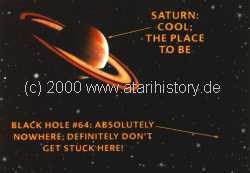 |
|
Anti-Nintendo-ad by Sega (1996) |
A final roar: The Jaguar 64
In the late 80s, Atari was thinking
about a new video-game-system with enhanced capabilities. They began to develop
a new-generation 32bit video-game-system, code-named "Panther".
In 1986, Martin Brennan and John
Mathieson started their own company called "Flare" with the purpose
to develop a new, high-sophisticated game-console with multiprocessor
capabilities.
After finishing the system, the small company needed money to bring the new
system to life. Richard Miller, who was vice-president of engineering at Atari
at this time, knew both developers of "Flare" and agreed to participate.
Atari, together with Mathieson and Brennan, founded a new company called "Flare
II" to continue development on this new system.
Development on the "Jaguar" was better and faster than expected and so
the "Panther" was
cancelled and all efforts were put into the "Jaguar".
In the summer of 1993, Atari announced the "Jaguar 64 Interactive
Multimedia System", the world's first 64bit video game-console and
presented IBM as the manufacturer of the new system. The Jaguar's chipset was
manufactured by Toshiba, Motorola delivered the 68000.
In November of 1993, the Jaguar hit the market to compete with the 3DO, that
just has been released a few weeks before. But Atari had two big advantages:
1. The price: The Atari Jaguar cost about $299, the 3DO $699!
2. Games: The Jaguar offered four of them when released; more than for the 3DO
system.
The current market-leaders were shocked. Sega quickly released an add-on for the
Genesis, but it "only" was 32bits. Nintendo didn't have to offer
anything at that time but a 64bit-system somewhere in the future without giving
any precise date or data. This was a big laugh in the gaming-society...
 |
|
Anti-Nintendo-ad by Sega (1996) |
...but Nintendo was the last one to
laugh!
In September 1995, Sony's Playstation was to be introduced to the market, and
the same month Atari released the Jaguar CD.
Atari's engineers were working on the Jaguar's succeeding-system: the "Jaguar
2" (codename: "Midsummer"). The chips, engineered by Atari and produced by Motorola, were
code-named "Oberon" and "Theseus". The "Jaguar 2" was thought to be 2 to 4 times faster than the Sony Playstation and
would have had the CD-ROM implemented. But there was noone ever to find out about
it...developers were considered to get the first systems in fall 1995...the rest
is history!
Atari didn't manage to do good promotion on the Jaguar; as usual...
Sony, on the other hand, launched a big television-commercial attack for its new
system. And by Christmas, all children in the US wanted to own what their
friends owned, as seen on television.
Atari made a good deal with Wal*Mart: they equipped over 400 super-stores with
their new product, hoping to sell lots of systems. But it turned out different.
In early 1996, Wal*Mart began to return the unsold stocks of Jaguars to Atari.
Atari was unable to find another distributor for the system to keep up sales,
because their funds were dropping and they had big problems staying afloat.
This marked the end of Atari as we knew it up to that day. On July, 30, 1996,
Atari enters a "reverse merger" with JTS, a small manufacturer of
hard-disk-drives and vanished from the market...
But the Jaguar wasn't really dead yet: some years ago, Atari Games licensed the Jaguar's design, added some modifications like a faster processor and a hard-disk, and built it into some arcade games like "Area 51". This system was called the "Co-Jag".
Atari did a great job developing the Jaguar; a great machine. But most of the programmers weren't able (or just didn't want to put more efforts) to program a relatively complicated machine like the Jaguar. The full potential of the machine was never reached...